Northeast India is the least-visited part of India, yet it’s packed with some of the best nature and outdoor offerings in the country. It has lofty Himalayan peaks, high passes, and glacial lakes, as well as lush jungles, rivers, and valleys, all of which are an intrepid playground for trekking, rafting, kayaking, safari and mountain biking — allowing people to travel for days or even weeks on incredible expeditions.
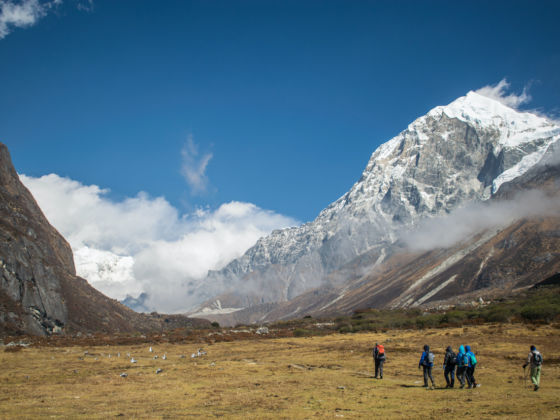
Northeast India Is the Country’s Most Adventure-Packed Region
The area is wedged between four countries — China, Myanmar, Bangladesh, and Bhutan — and comprises eight states: Arunachal Pradesh, Nagaland, Assam, Mizoram, Manipur, Tripura, Meghalaya, and Sikkim. A major reason this region is less visited is that traveling here isn’t easy. Some parts of the region have atrocious roads, long distances, curfews, inclement weather, and strict entry regulations.
Indian tourists must secure an Inner Line Permit (ILP) to visit Arunachal Pradesh, Manipur, Mizoram, Nagaland, and East and North Sikkim while foreigners are required to obtain a Protected Area Permit (PAP) for Arunachal Pradesh and both an ILP and PAP for Sikkim. We should note that foreigners visiting Mizoram, Nagaland, and Manipur must register themselves at the local Foreigner Registration Office (FRO) of the district they visit within 24 hours of arrival.
The bureaucratic and logistical challenges are real. However, if you manage them, the list of possible outdoor pursuits is long. We list the main ones here.
1.Trekking
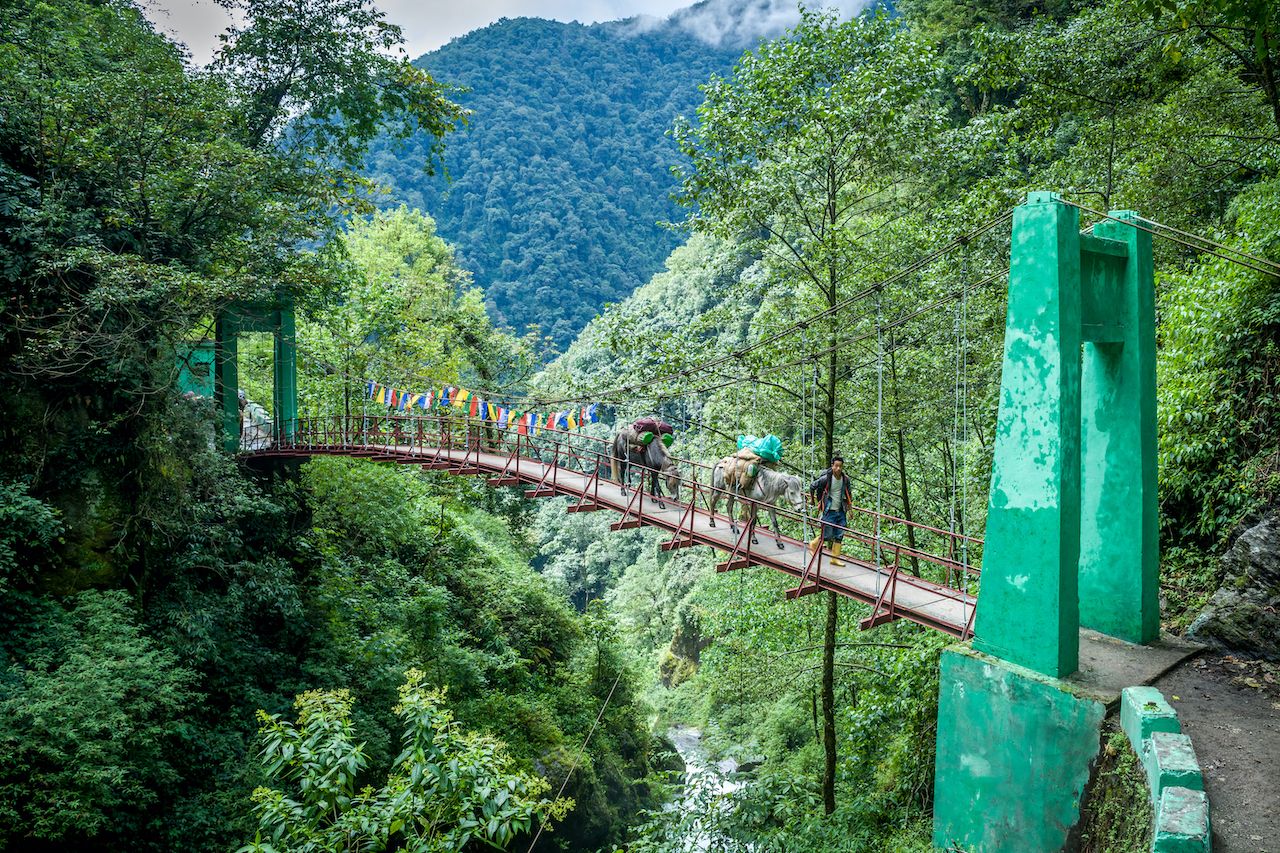
Photo: niladrilovesphotography/Shutterstock
Northeast India is full of mountains, high passes, and gorgeous valleys, which are perfect for everything from hardcore treks to gentle hikes. The most celebrated trek is located in Sikkim. The Goecha La is a rewarding (and challenging) journey that starts in Yuksom, at an elevation of 18,5000-plus feet, and winds from village to village. The path is arduous, to say the least, but you’ll be picking your jaw up off the floor when you see Mt. Kanchenjunga, the world’s third-highest mountain. It takes around 11 days to complete the Goecha La trek; you can spend nights in local guesthouses and trekkers’ huts along the way or pitch a tent.
For a dash of history with your trekking, try the Bailey Trail in Arunachal Pradesh. Under British rule, it was an ancient trade route that connected India, Tibet, and Myanmar (formerly Burma). It takes around eight to 12 days to complete this trail, starting from the Lagam village; passing through the Eastern Himalayan peaks of Gorichen and Kangto, as well as pristine pine and rhododendron forests; and taking in six high passes en route. At 14,927 feet, the Tse la Pass is the highest point of this trail. You’ll also come across villages of the Monpa tribe, which are a highlight of the journey.
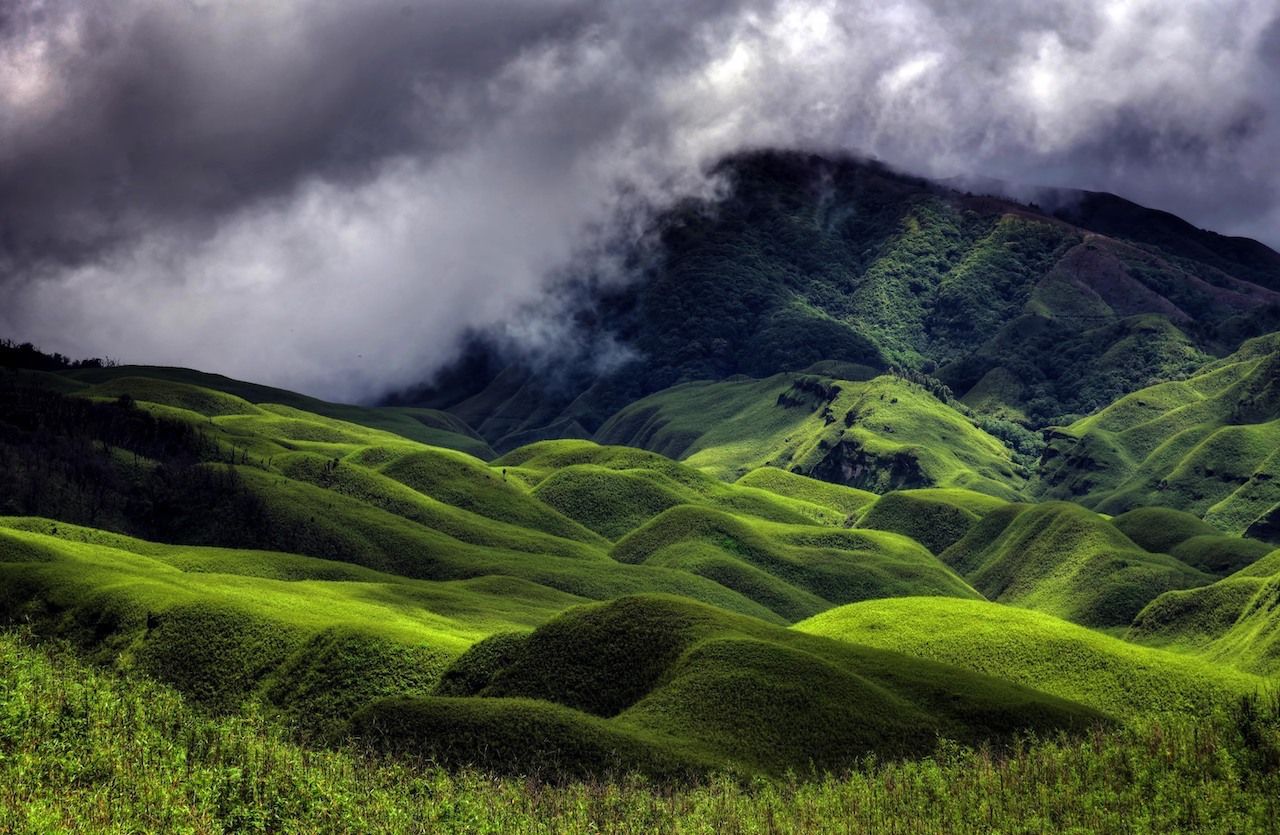
Photo: Dhruba Jyoti Baruah/Shutterstock
If you’re looking for a short and comparatively easy trek, Dzukou Valley is a perfect option. The trek commences from Viswema village, situated about 14 miles south of Kohima, the capital city of Nagaland. Over the course of five days, you’ll hike from temperate forests to lush green hills and rolling meadows dotted with colorful flowers. The path sometimes gets steep and slippery (depending on the weather), but that’s all part of the fun. The best time to trek here is from mid-June to August when the flowers are in full bloom. Keep an eye out for the rare Dzukou Lily, which is only found in this valley. As to where to stay, there’s one basic guesthouse with five rooms and two dormitories. Alternatively, you can pitch a tent and camp in the valley.
If an overnight stop is not for you, many treks in the region can be covered in one day. The David Scott Trail in East Khasi Hills in Meghalaya is a popular and easy trail. The hike starts from Mawphlang, winds through the Khasi hills, and ends at the Lad Mawphlang village. The total length of the trek is 10 miles and takes around five hours. During the walk, you’ll come across the sacred groves and serene Umiam river, where you can stop and relax.
Living Root Bridges in Meghalaya makes another great one-day hiking trip. The 180-year-old Umshiang Double-Decker Living Root Bridge in Nongriat village is the most famous living root bridge. The one-way hike to this bridge is fewer than two miles, starting from Tyrna Village. The journey is a bit tiring, but it’s worth it for the views. There’s also a single-decker living root bridge in Riwai, near Mawlynnong Village, and it’s more easily accessible compared to the bridge in Nongriat. You can reach it on foot in 15 minutes from Riwai Village. The best time to visit these bridges is from November to March. You can go there on your own, as the path is signposted, or opt for a tour with a local expert at Challo Hoppo.
2. Whitewater rafting
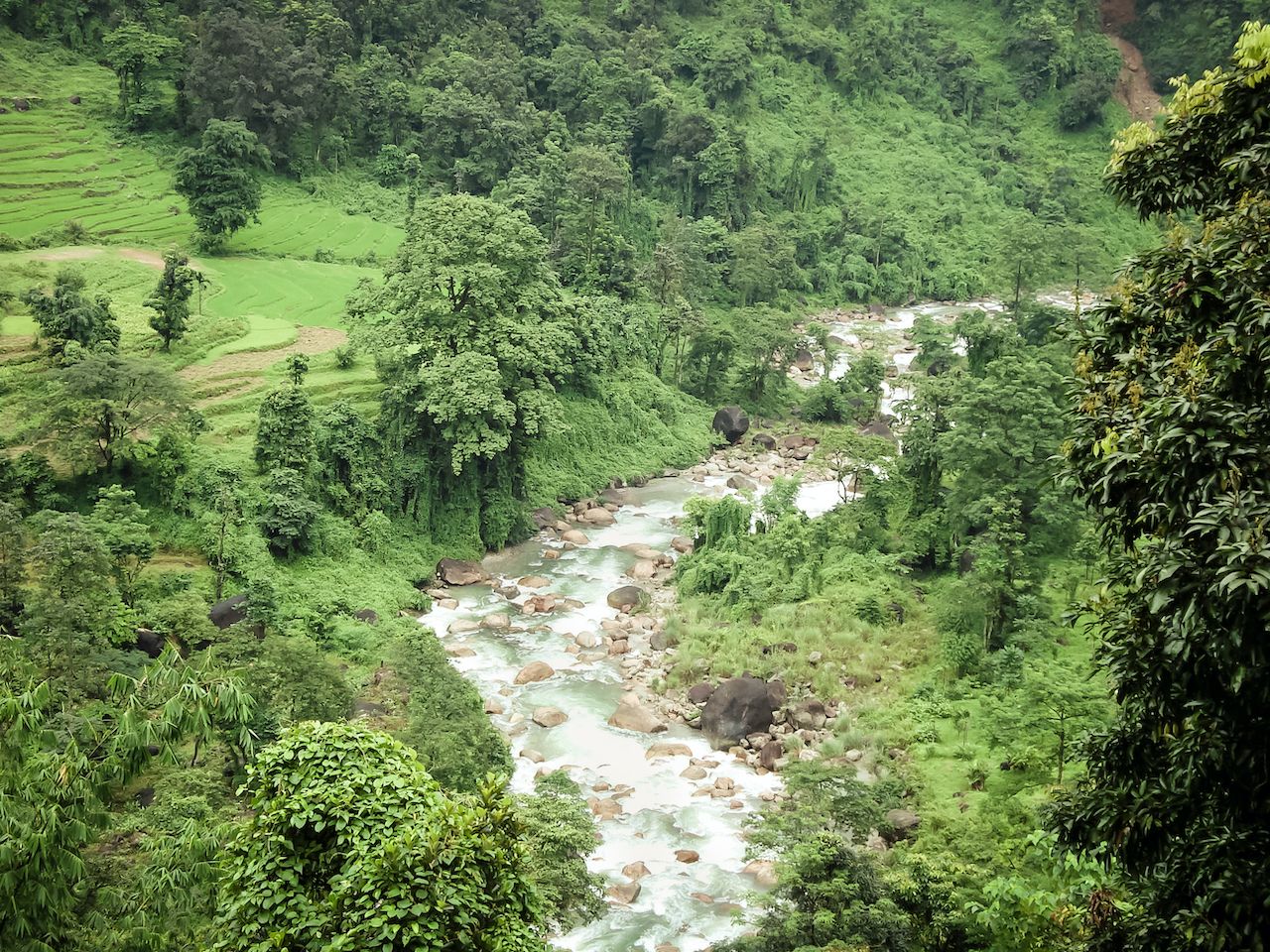
Photo: S B Stock/Shutterstock
The northeast region of India has rivers with Grade II to Grade IV rapids that make excellent whitewater rafting. One of the best rafting rivers is the Teesta River in Sikkim. It churns out Grade III-IV rapids, and you’ll encounter technically difficult rapids at the topmost emergence point of the river. Astounding views of slopes enveloped in thick forests, small villages inhabited by tribal folks, and distant terraced fields abound, as the river flows through the gorges in Sikkim Himalayas, ending at the town of Rangpo.
The Rangit river, a tributary of the Teesta River, is also a great destination for whitewater rafting enthusiasts. There are sections to suit all abilities, from novices on Grade II rapids to those willing to brave some exhilarating Grade IV rapids.
For a multi-day, or multi-week, rafting expedition, the whitewater of the mighty Brahmaputra River might be your speed. Considered to be one of Asia’s major rivers, the Brahmaputra is formed from the Angsi glacier in Tibetan Himalayas, and along the course, it meanders into India. The rafting excursion starts from Tuting and ends at Pasighat in Arunachal Pradesh roughly 110 miles later, with overnight stops on sand beaches.
The rapids get aggressive and difficult to navigate as the seven-day trip downriver progresses, climaxing in Grade IV rapids on the last day at the immaculate white river beach at Pasighat. Along the way, you’ll encounter numerous traditional villages, lofty hills, and dense jungles. Adding to the excitement, you might also get to see Ganges river dolphins and rare Siberian migratory birds up close. A wide range of outfitters offer equipment, instructions, and transportation to and from the departure point; Aquaterra Adventures is recommended. Early November to March is the best time to grab a paddle.
3. Road tripping — on a bike or in an SUV
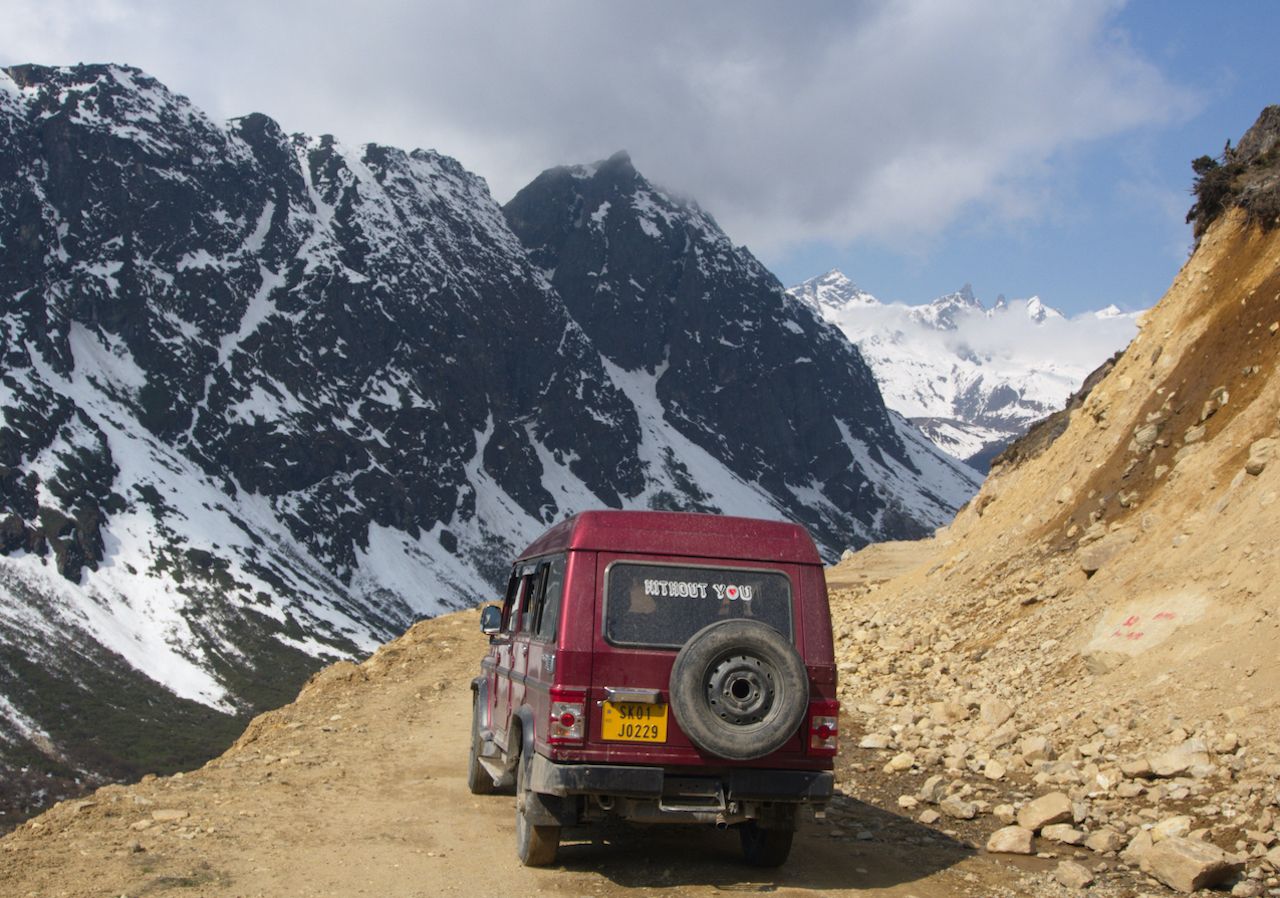
Photo: WeiShen/Shutterstock
Northeast India is huge, with an endless supply of amazing places to visit. Due to its vast size, however, it’s impossible to cover a lot of it in just one visit. So the best way to explore this part of India is through a good old-fashioned road-trip. One of the most popular routes in the region is from Gangtok to Yumthang Valley via Lachung in Sikkim — traversing some of the roughest, yet most breathtaking, terrain in the country. The route passes through high mountains, glacial lakes, sparkling waterfalls, hot springs, and a rhododendron sanctuary.
Make a mandatory stop at Gurudongmar Lake, one of the highest lakes in India, and Yumthang Valley, also known as the Valley of Flowers. Don’t forget to try the hot and spicy noodles and mint tea at one of the roadside food stalls along the way. However, first things first: You’ll need to contact a local travel agent who will sort out cabs and permits for you.
Adventurers who want to see some of the best sights Northeast India has to offer, while still exploring off the beaten track, should consider a trip from Guwahati (Assam) to Tawang (Arunachal Pradesh). You can rent a bike or an SUV in Guwahati. We recommend spending a day in Guwahati and exploring its cultural and historical attractions. The river island temple of Umananda and the Hindu temple of Kamakhya are must-see sites in the city.
From there, you can cross over to Tezpur on the banks of the Brahmaputra river. Then make your way over to Dirang Valley and stop at Bhalukpong police check post. This is where you cross over from the Assam border and enter Arunachal Pradesh. Before setting out from Dirang Valley, explore everything it has to offer. Check out the 500-year-old Kalachakra Gompa, Sangti Valley, and Dirang Dzong, a tribal area filled with traditional houses.
Make overnight stops at small towns like Tenga and Bomdila before heading to Tawang, a mountain town at an altitude of 10,000 feet. The journey is arduous, crossing the high-altitude Sela Pass and numerous hairpin bends, but well worth it for the mesmerizing scenery replete with snow-capped mountains and evergreen forests. While in Tawang, make sure to visit the 17th-century Tawang Monastery, the largest monastery in India. The entire route can be covered in five days, but you can extend your trip with longer stays.
If you’ve still got itchy feet when you reach Tawang, take National Highway 52, which leads to Ziro, where you can learn about the culture and heritage of the local tribal people. From there, you can head to Pasighat via the Along village and further to Dibrugarh in Assam. Here, explore the tea estates. Then jump on National Highway 37 and continue to Kaziranga National Park, which is home to two-thirds of the world’s one-horned rhinoceros.
Those who have limited time but still want to experience the northeast can go on a bike trip from Guwahati (Assam) to Cherrapunji (Meghalaya). The two-day journey features ancient megaliths, enchanting waterfalls, mysterious caves, and living root bridges. The best times for all of these routes are March-April and October-November.
4. Caving

Photo: SurabhiArtss/Shutterstock
Northeast India brings to mind snowy peaks, rolling green hills, lush valleys, flood plains, and cold wilderness. But underneath this diverse landscape hides another dimension of beauty: the caves. The hilly state of Meghalaya has the highest concentration of caves — 1,650 in total — and the most extensive of those can be found in the East Khasi, Jaintia, and South Garo Hills districts of the state. One of the must-visit caves is the Krem Liat Prah in the East Jaintia Hills district. Stretching a startling 21 miles, it is the longest natural cave in South Asia.
The Krem Puri Cave in the East Khasi Hills district is also very popular. Along with being the longest sandstone cave in the world, extending 15 miles in length, it also contains fossils of dinosaurs and giant reptiles dating back some 70 million years.
Another impressive cave is the Mawsmai Cave in Sohra (Sohar is popularly known as Cherrapunji). It’s one of the best-preserved underground sites in the region; it’s also fully illuminated and easier to get through. Just a few miles away is the lesser-known Arwah Cave. Inside this limestone cave, you’ll be squeezing and crawling through narrow holes and jumping through crevices, but the experience is well worth it as you’ll encounter stalactites and stalagmites that have taken tens of thousands of years to form, as well as fossils of fish bones and mollusk shells. Even the walk up to the Arwah Caves is beautiful, passing through a wooden bridge with mesmerizing views of the waterfalls and lush valley.
To explore these caves, we recommend hiring a local guide, which is readily available, or sign up for a caving expedition organized by Meghalaya Adventurers’ Association (MMA). Avoid caving during the monsoon season, which runs from May to September. The best time is November to March.
5. Kayaking

Photo: sashanka goswaami/Shutterstock
Kayaking in Meghalaya you’ll not only witness spectacular scenery but also gain insight into the local communities. The premier kayaking spot in Meghalaya is Umngot River, located in the border town of Dawki in the West Jaintia Hills district. It’s considered to be the cleanest river in the country. Outdoor enthusiasts flock here, staying either in a tent by the river or nearby bamboo huts, to enjoy the serene and crystal-clear water and to paddle against a backdrop of high mountains covered in lush greenery. You can even slip into the water for a swim.
There are several other kayaking locations in Meghalaya, including Kynshi River in the West Khasi Hills district and Umiam Lake in Shillong. The Kynshi River has sections with gentle stretches, as well as those with rougher waters strewn with massive rocks and boulders for experts. Regardless of your experience level, paddling through the river will be an adventure of a lifetime. On the other hand, paddling through the clear waters of the Umiam Lake, surrounded by hills and forests, is quite a peaceful ride. Stay at the boathouse in Lumpongdeng Island, a small island in the middle of the Umiam Lake.
October to April is the best time to go kayaking, and several companies arrange tours to do so. Pioneer Adventure Tour and sustainable tour company Kipepeo are your best bets.
6. Jungle safari
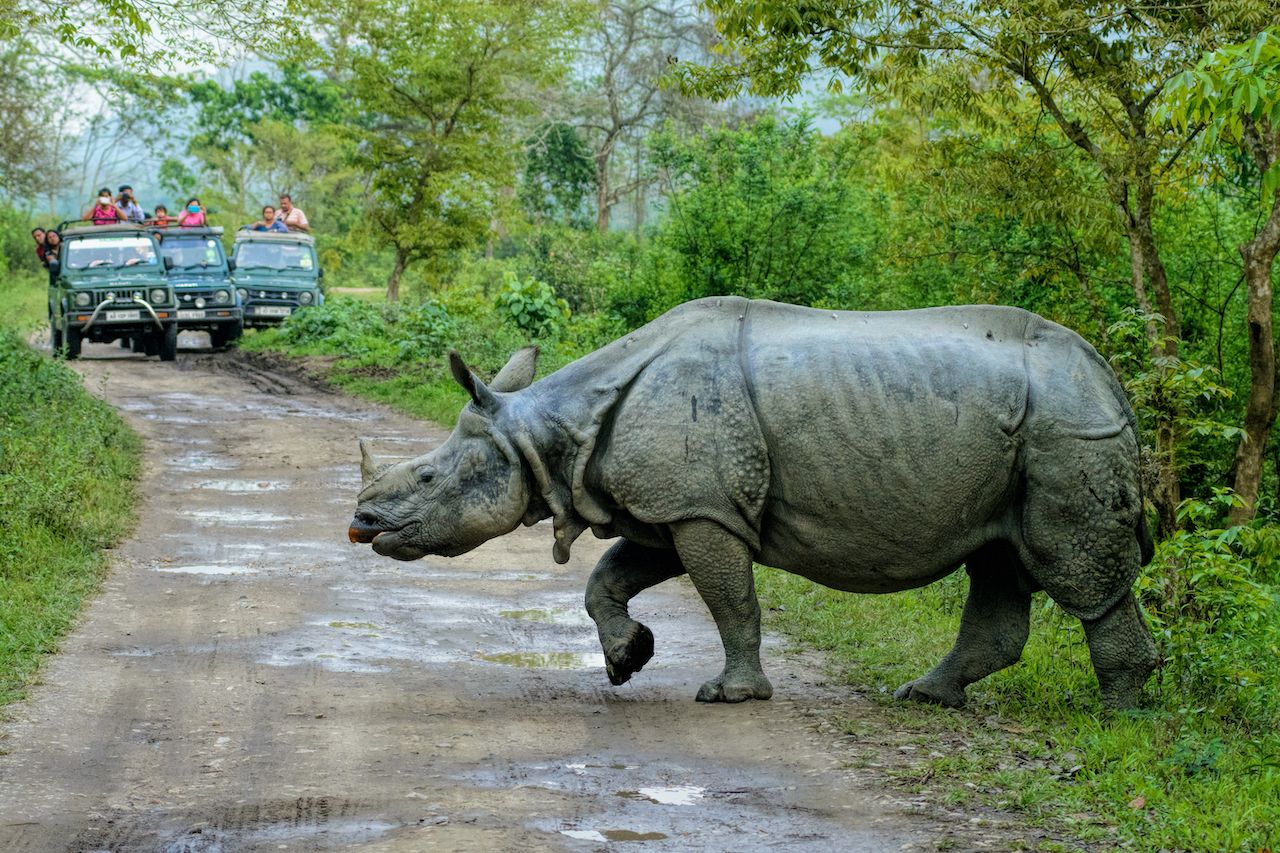
Photo: Mousam Ray/Shutterstock
Wildlife lovers looking for their next travel destination should seriously consider Northeast India. It’s blessed with expansive natural landscapes and wildlife sanctuaries that sustain abundant biodiversity. The most accessible of these is Kaziranga National Park in Assam. On a jeep safari here, you’re almost guaranteed to spot a one-horned rhinoceros as the park is believed to have the world’s highest population of this endangered creature. Tigers also live here but are more elusive. In addition, the park is home to elephants, sloth bears, swamp deer, leopards, and thousands of resident and migratory birds.
Another biodiversity hotspot is Manas National Park, which spans the Manas River in Assam. Safaris by jeep or elephant — although we discourage riding elephants — take you through its forested hills and alluvial grasslands where you can spot hispid hare, Assam roofed turtle, golden langur, Bengal florican, and pygmy hogs, which can only be seen in India.
Book a wildlife tour with Greener Pastures, a sustainable travel company that focuses on protecting the environment and uplifting local communities.
7. Paragliding
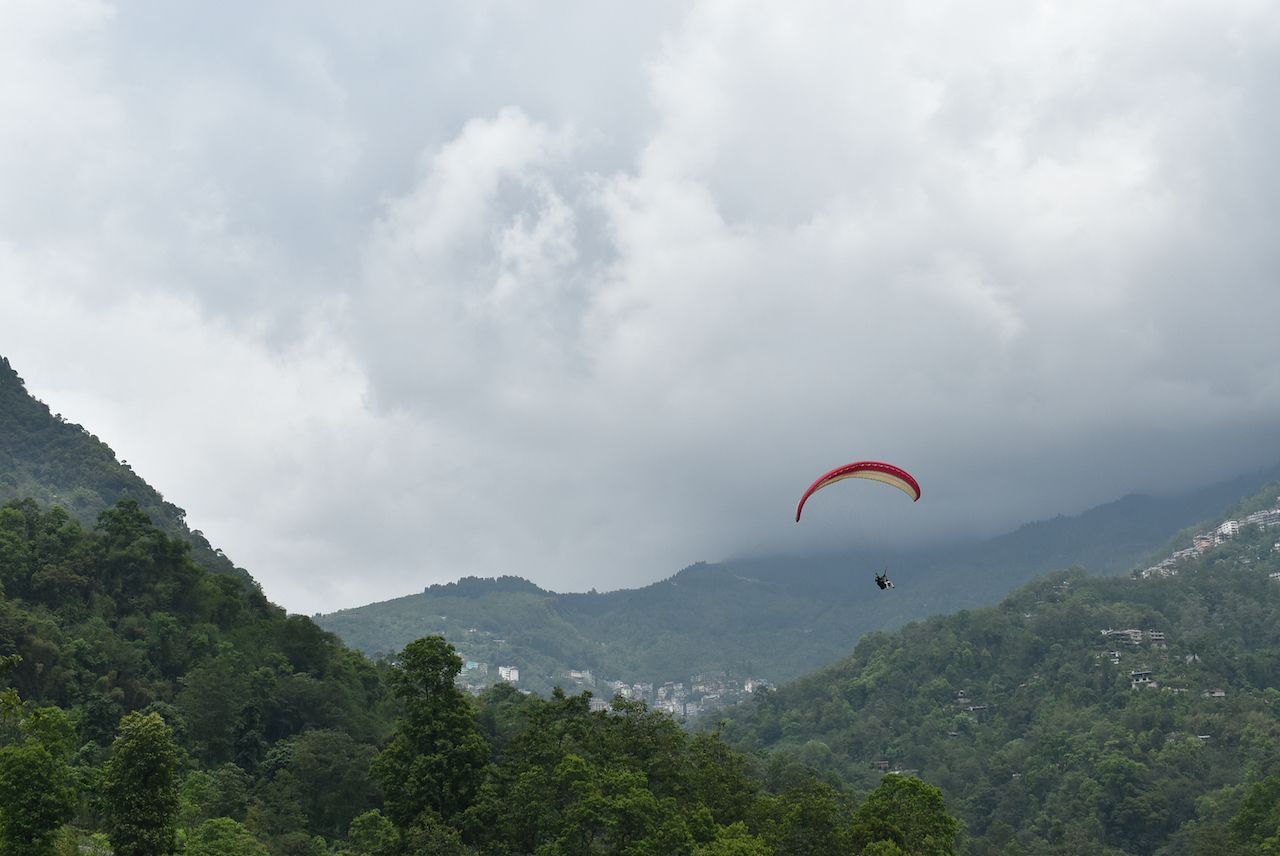
Photo: Sumit Sangam/Shutterstock
Experiencing Northeast India on land is enjoyable enough, but getting a sweeping view of the remote landscape from the skies is unforgettable. The best place for paragliding in the region is Gangtok, which has two main flying locations: Baliman Dara-Resithang Village and, beyond it, Bulbuley Dara.
Both locations offer tandem flights. The former is suitable for Medium Fly flight, where you’ll fly at an altitude of 4,265 to 4,593 feet for around five to 10 minutes, while the latter is best suited for High Fly flight, where you’ll fly at an altitude of 7,218 feet for around 20-30 minutes. Regardless of which location you decide to paraglide over, the views are awe-inspiring. Expect to see verdant valleys, glacial lakes, and the majestic Himalayan mountain ranges of Gangtok as you glide through the air.
You can choose from several professional companies; Fly Sikkim Adventure and Sikkim Paragliding have solid reputations. This adventure is comparatively expensive but affordable by European or North American standards. You’ll pay over $35 for Medium Fly and $62 for High Fly flight, plus an additional $7 for video. Optimal months are from March to June and September to November.
8. Skiing
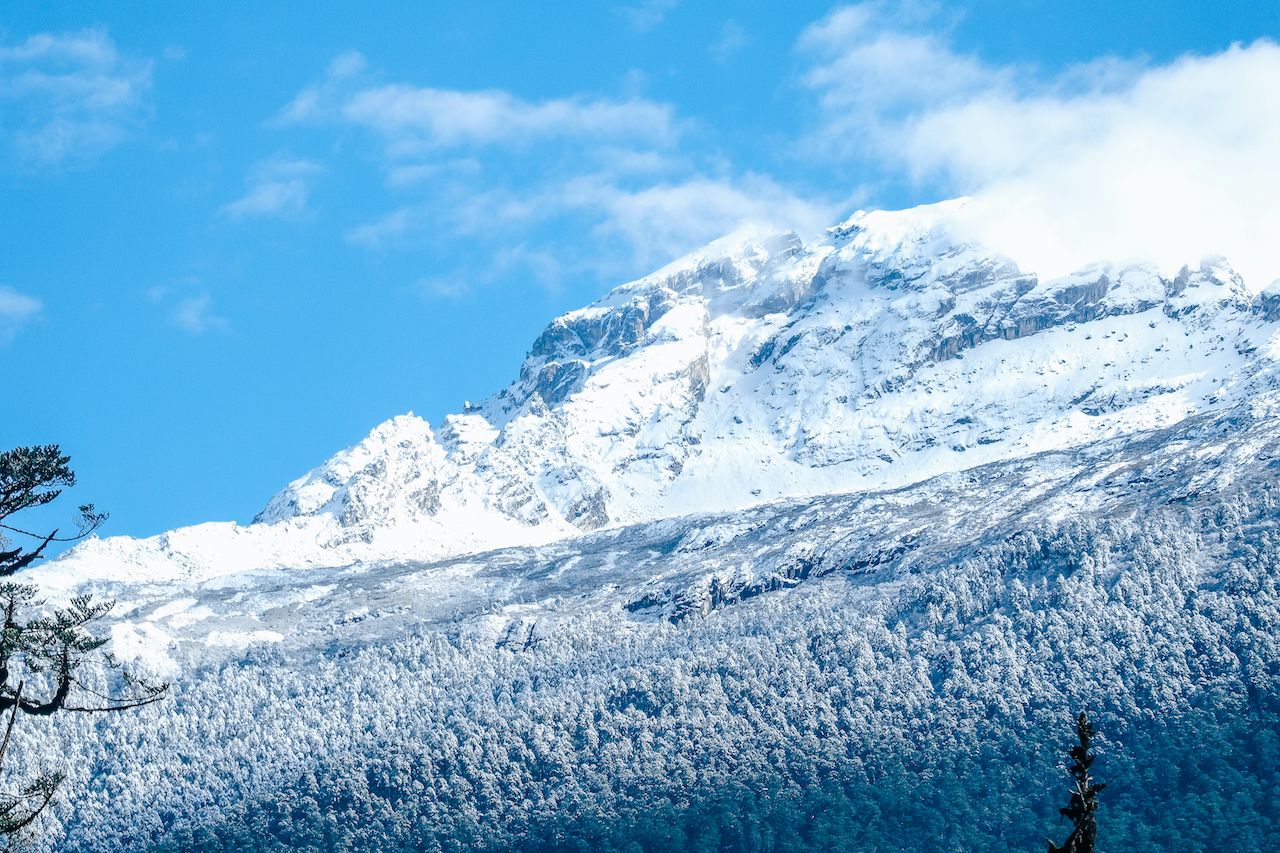
Photo: Chanunphat/Shutterstock
In the cooler months (November to March), many places in Northeast India get blanketed in snow. Peaking at an altitude of around 10,000 feet, Pankang Teng Tso Lake in Tawang (Arunachal Pradesh) has some of the best slopes for skiing but is a bit lacking in infrastructure. There’s only one ski lift to carry skiers uphill, and you’ll need your own ski gear.
At an elevation of 11,000 feet, Phuni Valley in North Sikkim is another good ski area. Fresh powder and vast slopes make it ideal for both beginner and advanced skiers. Paid guidance is easily available, as is rental equipment. There’s also a low-key ski scene at Yumthang Valley, not too far from Phuni Valley. Yumthang is mainly known for its vast stretch of multi-colored flowers that burst into bloom in late February and continue through mid-June, but as the winter approaches, it gets covered in snow. The terrain isn’t as well-groomed, but it offers an opportunity for off-piste skiing.
9. Zip lining
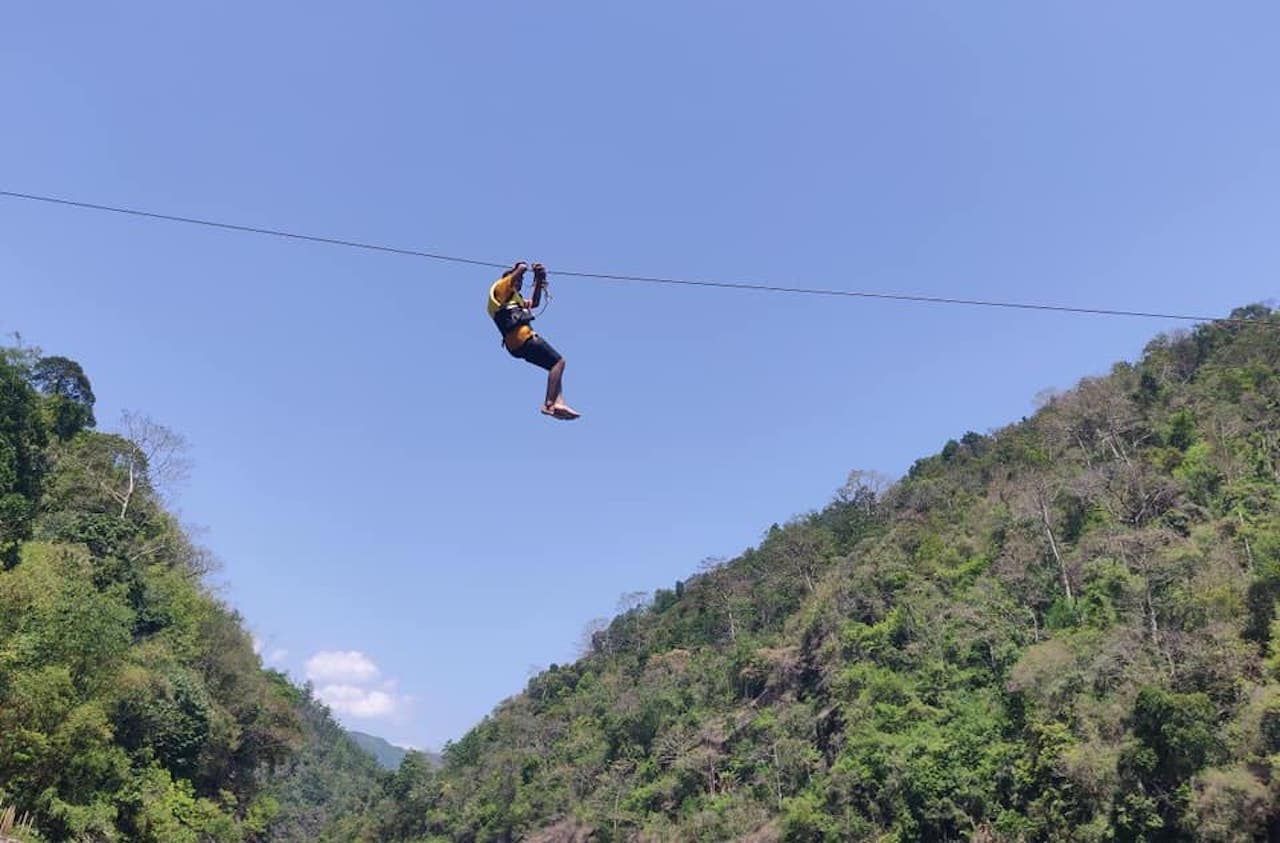
Photo: Pioneer Adventure Tours Shillong/Facebook
The best locale for zip lining in Northeast India is Mawkdok-Dympep Valley in Sohra, previously known as Cherrapunji. It will allow you to soar 1,200 feet above the base of the valley, across two lines, with lengths measuring 1,089 feet and 2,600 feet. As you glide over the valley, you’ll get the chance to enjoy the fresh air and a bird’s-eye-view of the lush Khasi hills. Check out Pioneer Adventure Tours.
10. Waterfall rappelling
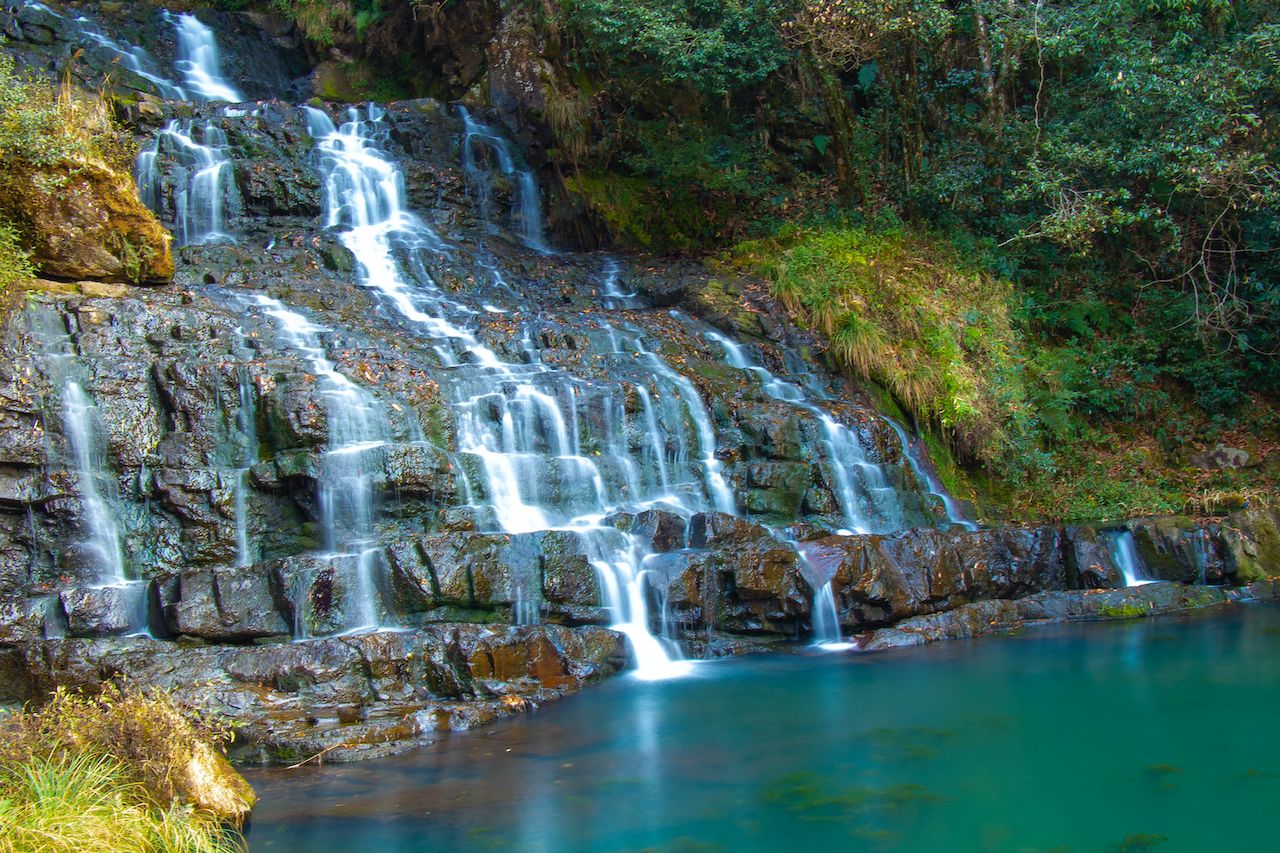
Photo: sricharan yalamanchili/Shutterstock
Hiking to waterfalls is one thing, but rappelling down the falls will provide an adrenaline rush like no other. This activity can be done at 40-feet-high Elephant Falls in Shillong. Offering spectacular views as you descend down this multi-tiered waterfall of moderate intensity, you’ll be captivated by the surrounding beauty. Contact a local tour operator to indulge in this adventure activity. Amsoi village in Assam is another great destination for waterfall rappelling.